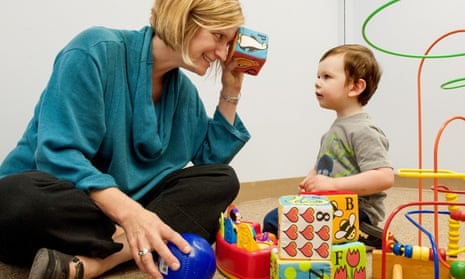Babies who are most at risk of developing autism as toddlers have been identified from brain scans in the first year of life.
The images helped doctors spot which of a group of children who were already at risk because of autism in the family would later be diagnosed with the condition.
The work raises hopes that affected children could be helped with earlier specialised care and interventions to help their social abilities before any behavioural symptoms start to appear.
Scientists studied 106 babies, all of whom had an older brother or sister with autism, and found that telltale features in brain images taken at six and 12 months revealed which infants would go on to have an autism diagnosis.
The technology is not ready to use in clinics, but researchers who took part in the study believe it lays the groundwork for a tool that can predict autism in high-risk babies before their first birthday.
“We don’t have such a tool yet, but if we did, parents of high-risk infants wouldn’t need to wait for a diagnosis of autism spectrum disorder at two, three or even four years,” said Annette Estes, a co-author on the study and director of the University of Washington in Seattle. “Researchers could start developing interventions to prevent these children from falling behind in social and communication skills,” she added.
About one in 70 children in the UK develops autism, but among those with a diagnosed sibling, the risk of the condition can rise to about one in five. The test has not been tried on children who are not at high risk.
Writing in the journal Nature, the scientists describe how they compared brain scans of high-risk babies with those from 42 low-risk children who had no siblings with autism. On each lab visit, scientists assessed the children’s behaviour and intellectual abilities.
The images, taken as the babies slept, revealed that high-risk infants who developed autism experienced a “hyperexpansion” of the brain’s surface in the first year of life. The unusual growth preceded a rise in brain volume over the following year that was linked to social difficulties the children developed.
The scientists next used a machine learning algorithm to predict from the scans and the infant’s sex which high-risk children would be diagnosed with autism at the age of two. The computer identified eight in 10 of those who developed autism. In about 3% of cases, it predicted autism that did not appear.
Estes said that by the time children are diagnosed at the age of two to four years old, they have often already fallen behind their peers in terms of social skills, language and communication. Once children have missed those developmental milestones, she added, catching up is a struggle for many and nearly impossible for some.
“Our hope is that early intervention, before age two, can change the clinical course of those children whose brain development has gone awry and help them acquire skills that they would otherwise struggle to achieve,” said Stephen Dager, a co-author at the University of Washington’s Center on Human Development and Disability.
Carol Povey, director of the National Autistic Society’s Centre for Autism, said: “If confirmed by further research, it’s possible that MRI scanning of this type could be developed to help families who already have an autistic child to access earlier diagnosis for subsequent children. This would mean those children could receive the right support as early as possible.
“It is important to highlight, however, that autism is a complex condition which manifests in many different ways. No single test is likely to be able to identify potential autism in all children, but this technology could help simplify and speed up the route to autism assessment for some children.”
